#Apparel Sourcing Week 2022
Explore tagged Tumblr posts
Text
Solar Institute Post #2
(21/06/2022)
FELLOW INSTITUTE MEMBERS: APOLOGIES FOR THE EXTENDED TIME BETWEEN BULLETINS. SINCE OUR LAST EXCHANGED DISPATCHES, MY RESEARCH MISSION HAS TAKEN ME FROM THE STATES TO EUROPE, AND I WORK DAY TO NIGHT DELIVERING OUR MESSAGE AND RECORDING FIELD DATA. HERE, I AM PLEASED TO REPORT THAT THE PRESENCE OF SOLAR POWER IS ALIVE AND WELL. THE SUBJECTS' LIMBS ARE TANNED AND BARE, THEIR LIPS APPEARING JUICY AND WELL MOISTURIZED. THEIR PHYSICAL APPEARANCE HAS BEEN RECORDED AS "SUPER HOT" IN OUR LEDGERS. I AM PLEASED TO REPORT SIGNIFICANT LYRIC RECALL AND LUNG CAPACITY BEING PROVEN AT OUR NIGHTLY INSTITUTE GATHERINGS ACROSS THE CONTINENT. IT SHOULD BE NOTED THE WORDS "BIG SLAY", "GAY RIGHTS" AND "BELLISSIMA" ARE OFTEN SPOKEN IN CONJUNCTION WITH THE SPREADING OF OUR MESSAGE— I WOULD SUGGEST THE RESEARCH TEAM PREPARE A DOSSIER. I FEEL THE INSTITUTE'S MESSAGES ARE BEING COMMUNICATED EFFECTIVELY, SPECIFICALLY THOSE RELATING TO HELIOCENTRIC WORSHIP, APPRECIATION OF THE NATURAL WORLD, THE MANY BENEFITS OF NEVER SPENDING A BLUE DAY INSIDE, DIPPING INTO OCEANS FOR MEDICINAL PURPOSES, AND THE USE OF MARIJUANA AS TOOL FOR INTROSPECTION AND SENSORY 'ZING'. PLEASE FIND ATTACHED SOME PHOTOGRAPHIC EVIDENCE OF INSTITUTE GATHERINGS AND OTHER FIELD DATA COLLECTION TRIPS. ON THIS DAY, SUMMER SOLSTICE OF THE YEAR 2022, IT IS MY WISH THAT YOU ARE TAKING A BREAK FROM YOUR EFFORTS TO OBSERVE OUR TEACHINGS. FEELING THE SUN ON YOUR SKIN FOR A MINIMUM OF ONE HOUR IS RECOMMENDED. SHARING YOUR EXPERT FINDINGS WITH THE INSTITUTE'S EMAIL TALK LINE IS ALSO RECOMMENDED. SOUTHERN HEMISPHERE MEMBERS MUST NOTE THE PRESENCE OF THE MATARIKI STAR CLUSTER APPEARING IN THE NIGHT SKY THIS WEEK— AN EARLY MORNING TRIP TO THE BEACH OR LOCAL MAUNGA TO OBSERVE THE CLUSTER IS MANDATORY. PLEASE FIND ENCLOSED TWO NEW UNIFORM APPAREL PIECES, ONE SUITABLE FOR MEMBERS IN EACH HEMISPHERE. THESE PIECES DENOTE INSTITUTE MEMBERS WORLDWIDE, SO ACCESS MUST BE GRANTED ONLY TO OUR MEMBERS. IF A NEW BOO TRIES TO PUT ONE OF YOURS ON COMING BACK FROM THE BEACH BECAUSE THEY LIKE THE SICK DESIGN, YOU MUST POLITELY BUT FIRMLY ASK THEM TO REMOVE IT IMMEDIATELY. SENDING "LOVE AND LIGHT" FROM THE FIELD. UNTIL WE ARE REUNITED LATER IN THE YEAR, REMEMBER TO BREATHE OUT, TUNE IN, GET LOST, BREAK A SWEAT, SWIM DEEP. E
VARIOUS EVIDENCE OF SUN WORSHIP GATHERINGS ACROSS EUROPE. BRAINS SUFFICIENTLY MELTED AT EACH LOCATION




TEMPORARY INSTITUTE MEMBER MARLON WILLIAMS ADOPTING OUR TEACHINGS DURING SOUNDCHECK

VARIOUS PERSONAL HELIOCENTRIC DATA COLLECTION TRIPS IN MUNICH, ROME, LAKE GARDA AND ZURICH. GRANITA PROVING ESSENTIAL AS RATIONS TO COMBAT HEAT





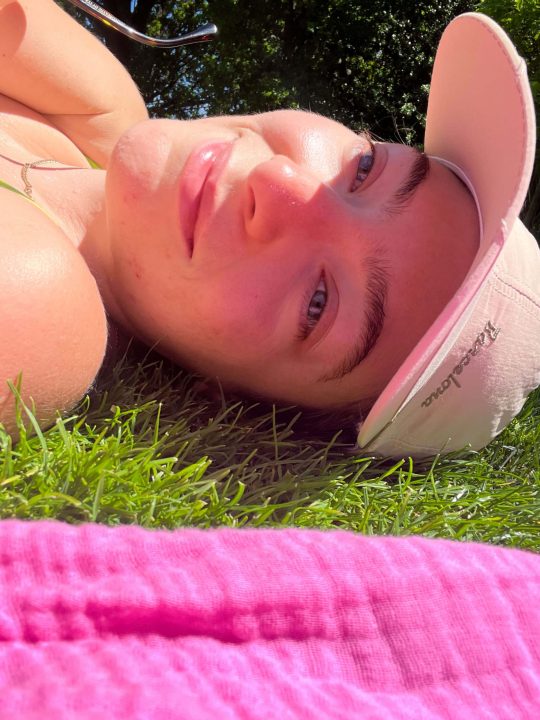



(source: solarinstitute.co.nz)
2 notes
·
View notes
Text
Week 7: Social Media Influencers and the Slow Fashion Movement

Photo illustration by Matthew Cooley
_______________________________________________________________________
What is slow fashion?
Slow fashion isn’t just about clothes, it’s linked to the sustainable consumption movement (Chi et al 2021). It promotes a lifestyle of choosing clothes that last a long time and making choices that are kind to the environment and people.
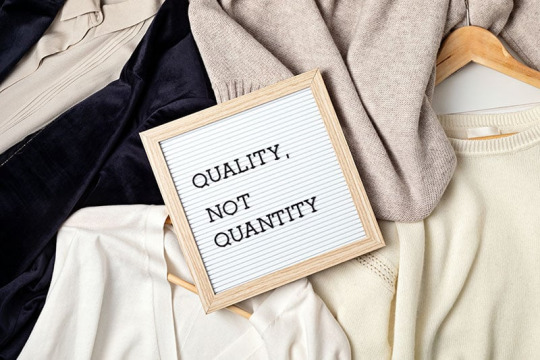
(Marshall 2022)
_______________________________________________________________________
Influencers and Digital Citizenship
Social media influencers play a significant impact on our buying behavior.
According to the PCB report(Product Content Benchmark ), 49% of consumers have made a purchase based on an influencer’s recommendation(ekilgore 2025).
It’s not exactly surprising, especially for our generation. We tend to trust influencers almost completely due to the content what they create and share with us on platforms like YouTube, TikTok, and Instagram.
_______________________________________________________________________
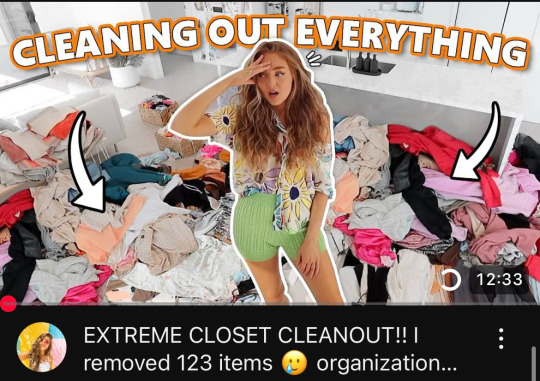
Source: @sarahjanebetts
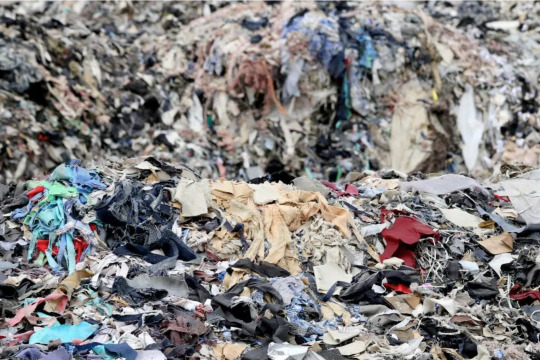
(Igini 2023)
The Negative Side of Influencers
Of course, influencers don’t always have a positive impact, there are negative sides too.
For example, in some case, when influencers post massive fast fashion hauls, it often encourages overconsumption. Some influencers even promote sustainability while still wasting or throwing away huge amounts of clothing, which clearly goes against the values they claim to support. This kind of behavior relates to the issue of SUSTINABILITY.
I believe they have a responsibility to think carefully when they deliver something to audience. _______________________________________________________________________
Consumer Thoughts on Slow Fashion
Style over trend. Ethics over price
Consumers who choose slow fashion are not making decisions based on design alone, but are shopping with an awareness of “where, who, and under what conditions” the clothes were made(Domingos et al., 2022). Furthermore, they choose clothes by considering how these clothes affect the environment and whether the working conditions are properly met.
For them, clothes are not only fashion items, but also communicate their values and ideas.
_______________________________________________________________________
Ultimately, it’s up to you what you want to wear. But influencers need to take responsibility for what they deliver.
_______________________________________________________________________
References
Chi, T, Gerard, J, Yu, Y & Wang, Y 2021, ‘A study of U.S. consumers’ intention to purchase slow fashion apparel: understanding the key determinants’, International Journal of Fashion Design, Technology and Education, vol. 14, no. 1, pp. 101–112.
Domingos, M, Vale, VT & Faria, S 2022, ‘Slow Fashion Consumer Behavior: a Literature Review’, Sustainability, vol. 14, no. 5, pp. 1–15.
ekilgore 2025, Consumer Survey Data: What Shoppers Really Think About Social Commerce and Influencers, 1WorldSync.
0 notes
Text
WEEK 11-12 OF BUSINESS INTERVIEWS

Last November 22 Jessa, Francen, Angel, and I conducted the sixth part of our interviews with five business owners, each with a different type of business. Before starting the interviews, we asked for their permission to take video or audio recordings for documentation purposes. We prepared a set of questions for them to answer, focusing on their businesses. ----------------------------------------------------
1. BER2BYTES

Ber2Bytes is owned by Mr. Daniel Vincent Bertubin and is located at Metz Arcade, Barangay 24, Capt. Vicente Roa St., Cagayan de Oro City. The business was established in July 2023. Ber2Bytes specializes in selling surplus or pre-owned laptops and accessories. Currently, the business operates 12 branches, with the Cagayan de Oro branch offering the most affordable laptops compared to other locations, according to Ms. Rube Bongulan, a staff member we interviewed. The laptops sold in the store are imported from Japan. The branch employs two staff members and is open from 10 AM to 7 PM, Monday to Sunday. However, on Sundays, their operating hours are shortened to 2 PM to 6 PM. Regarding documentation, the business has acquired all the necessary permits and certifications to operate, including a business permit, barangay clearance, DTI registration, Certificate of Registration (COR), sanitary permit, and official invoice receipts. One of the challenges they face is in repairing devices, as they are not always able to resolve technical issues. ----------------------------------------------------
2. ROSE APPAREL
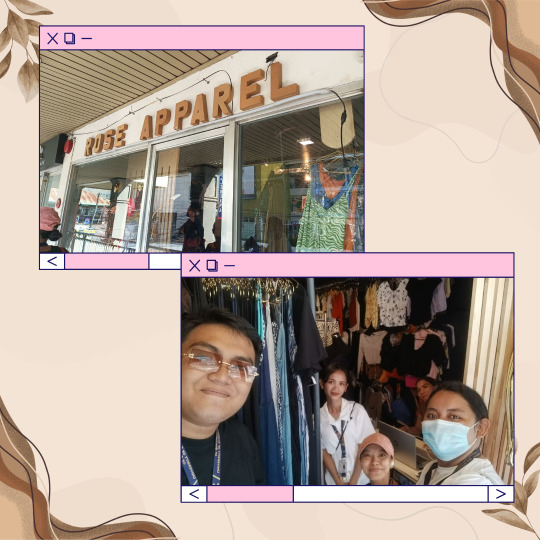
Rose Apparel is owned by Ma'am Rose Loyola and operates a single branch located at Metz Arcade, Barangay 24, Capt. Vicente Roa St., Cagayan de Oro City. The business was established in 2022. The store has one staff member, Marga, whom we interviewed. Their clothing supplies are sourced from Manila and shipped in bundles. Rose Apparel primarily sells women's clothing, although they also offer a limited selection of men's apparel. The store is open from 10:00 AM to 8:30 PM, Monday to Sunday. One challenge the business occasionally faces is the lack of customers, which can result in lower sales. Regarding documentation, the store has acquired the necessary permits to operate, including a business permit and DTI registration. ---------------------------------------------------
3. OSMEÑA HYDRAULIC HOSE AND BEARING CENTER INCORPORATED
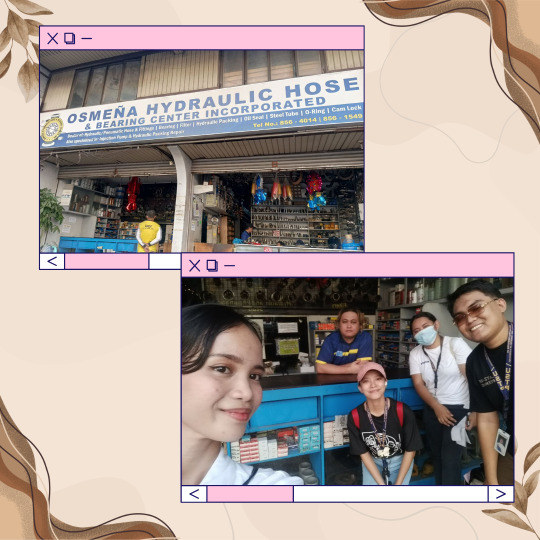
The business is a corporation owned by Mr. Leonard. It was originally established in the 1980s, but the current name of the store was adopted on September 25, 2017. The store is located on Osmeña Street, Cagayan de Oro City. The business specializes in selling bearing materials, hydraulic hoses, hose fittings, filters, and related products. Their supplies are sourced from Manila. The store employs a total of 11 staff members, including Mr. Roy, whom we interviewed. He serves as the accountant for the business. As a corporation, the business is registered with the Securities and Exchange Commission (SEC). Regarding documentation, they have acquired all necessary permits, including a Certificate of Registration (COR), Certificate of Occupancy, and Fire and Safety Inspection Certificate. ----------------------------------------------------
4. MOTO TRUCK

MOTO TRUCK is owned by Mr. Patrick Chua and is located at 278 Osmeña Street, Cagayan de Oro City. The business specializes in selling spare parts and has been operating for approximately 30 years. The company has a total of three branches: the main branch on Osmeña Street and additional branches in Cugman and Valencia. Their supplies are sourced from China. The business employs a total of 30 staff members across its branches. According to Ma'am Yasmin Kris Hachero, one of the staff members we interviewed, the store is not currently facing any problems. She also mentioned that all staff are required to undergo training and seminars before starting work. The business has obtained all the necessary documents for its operations, including a business permit, DTI registration, and official invoice receipts.
5. WANNABEES FAMILY KTV
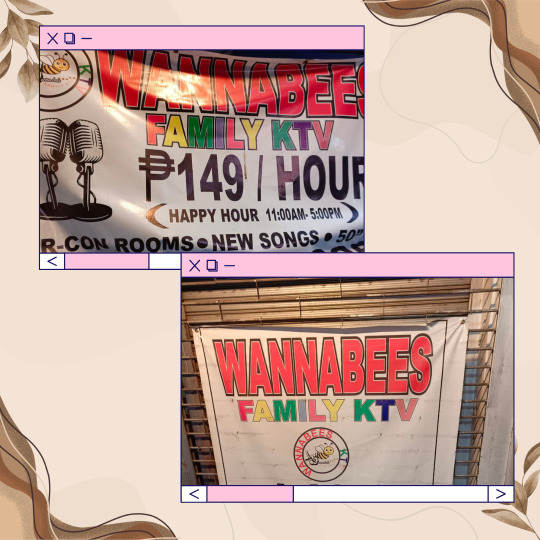
Wannabees Family KTV is owned by Ms. Wilma Go and was established in November 2023. The KTV is located on Max Y. Suniel Street, Cagayan de Oro City, and employs a total of three staff members. The business is centered around karaoke, providing a space where people can enjoy singing and having fun with friends. They offer a "Happy Hour" promotion from 11:00 AM to 5:00 PM, during which customers can enjoy discounts on their purchases. Wannabees Family KTV has acquired the necessary documents for its operations, including DTI registration, a business permit, and barangay clearance. The location for the business was carefully planned to ensure its success. The idea for the business stemmed from the owner's love of singing. ---------------------------------------------------
LINK TO THE INSIGHTS OF WEEK 11-12
0 notes
Text
Week 11-12 of Interviewing Different Businesses
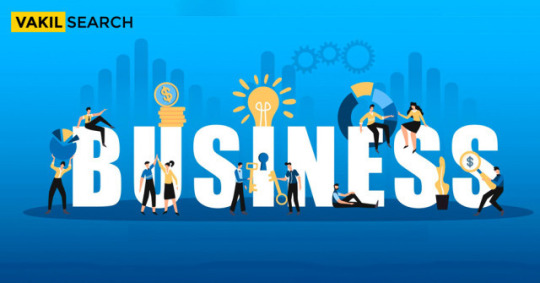
Me and my groupmates, Angel Jean Obsioma, Ian Gariel B. Ramas, and Francen P. Sellote, roam around the city to look for businesses that we can go to and ask the business owner or staff if we can ask a few questions regarding their business, so that we can gain knowledge and in-depth understanding about how business works, and we also asked permission if it is okay to take a picture.
Here is the list of the businesses we interviewed and the key information we gathered for week 11. 1. Ber2Bytes

Ber2Bytes is owned by Mr. Daniel Vincent Bertubin, established the Cagayan de Oro branch located at Metz Arcade, Barangay 24 Capt. Vicente Roa St., of their business in July of last year. They specialize in selling surplus or pre-owned laptops and accessories, offering some of the most affordable prices in the Cagayan de Oro branch. In addition to sales, they provide repair services, and their supplies are from Japan Surplus. The business has expanded to 12 branches, including locations in Iligan, Dipolog, Bukidnon, and the main branch in Dumaguete. They operate from 10:00 AM to 7:00 PM, Monday to Saturday, and from 2:00 PM to 6:00 PM on Sundays. To ensure compliance, they hold a business permit, barangay clearance, DTI certification, certificate of registration, sanitary permit, and issue official invoice receipts.
2. Rose Apparel

Rose Apparel, owned by Ms. Rose Luyula, was established in 2022 and is located in Brgy. 24, Capt. Vicente Roa Street, Cagayan de Oro. The store offers a variety of clothing, including tops, dresses, and shorts, catering primarily to ladies. This is their only branch, and they operate with a single staff member. Their business hours are from 10:00 AM to 8:30 PM, Monday to Sunday. The clothing items are sourced from suppliers in Manila. With a business permit and DTI registration, Rose Apparel upholds compliance.
3. Osmeña Hydraulic Hose & Bearing Center Incorporated

Osmeña Hydraulic Hose & Bearing Center Incorporated is a one-man corporation owned by Mr. Leonard and is located on Osmeña Street, Cagayan de Oro. Originally established in the 1980s, the business underwent a rebranding on September 25, 2017, adopting its current name. The company specializes as a dealer of hydraulic and pneumatic hoses and fittings, bearings, filters, hydraulic packing, and more. Additionally, they provide hydraulic packing repair services, showcasing their versatility in the industry. Sourcing their supplies from Manila, they operate with a team of 11 staff members and are open from Monday to Saturday, 8:00 AM to 5:00 PM. With a single branch, they maintain a solid reputation, supported by their compliance with legal requirements, including a certificate of registration, certificate of occupancy, fire and safety inspection, and SEC registration.
4. Moto Truck

Moto Truck, owned by Mr. Patrick Chua, has been serving the community for approximately 30 years. The business operates three branches, located in Cugman, Valencia, and the main branch at 278 Osmeña Street, Cagayan de Oro. Specializing in truck spare parts and accessories, Moto Truck caters to a wide range of customer needs with supplies obtained directly from China. They have a total of 30 staff members, the business is open from Monday to Saturday, 8:00 AM to 4:30 PM. To ensure compliance and reliability, Moto Truck holds a business permit, is DTI-registered, and provides official invoices. 5. Wannabees Family KTV
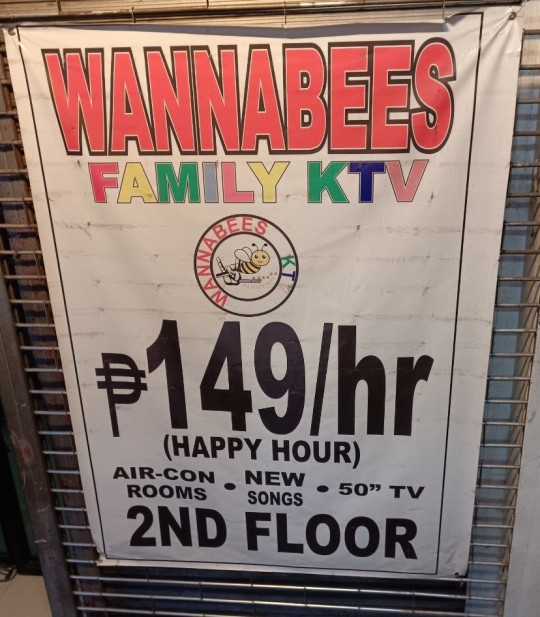
Wannabees Family KTV, owned by Ms. Vilma Go, started in 2023 and is located on Max Y. Suniel Street in Cagayan de Oro. The business is a place for families and friends to enjoy singing together. It is open every day from 11:00 AM to 1:00 AM and has three staff members. Ms. Go decided to open this business because of her love for singing. The business proudly holds a DTI registration, ensuring its credibility and compliance.
Here is the link for you to access my insights.
- J
0 notes
Text





WEEK 7-8 Blog
Invogue Fashion
Florence Vecino opened Invogue Fashion in 2018, a boutique in Cagayan de Oro that has become a go-to for trendy shoppers. With just two staff, Florence keeps things personal, often giving discounts to customers when she’s in-store. Invogue has also expanded with a pop-up shop at Shopwise. This small business shows that good service and a friendly vibe make a big difference in a competitive market.
Glaze 8
Glaze 8 started as a family donut-making hobby but quickly grew into a popular shop with 17 locations around CDO. Since the first branch opened in December 2022, the Navarro family has built a loyal customer base through community events, social media, and holiday specials. Known for their 70 unique donut flavors, they offer discounts for seniors and PWDs, keeping customers happy and coming back for more.
Kick Tees and Apparel
Owned by Charlie Dela Torre, Kick Tees and Apparel is a favorite for sneaker fans in CDO. They sell everything from high-end sneakers to affordable styles and run specials like “2 for ₱299” deals to attract new customers. Staff member Christian Jay says the store uses Facebook to boost sales, while the team works hard to serve customers, even when things get busy. Their stock comes from Vietnam and Manila, giving shoppers a wide selection to choose from.
AdTech Computers
AdTech Computers, owned by Rex with admin support from Anne Dizon, has been serving tech enthusiasts and professionals since 2010 in Iligan and 2018 in CDO. Technician Phyll Joseph "PJ" Oanes notes that AdTech offers a variety of products, from basic to high-end, while providing support services like repairs and customization. Instead of growing quickly, AdTech focuses on building a skilled team and providing quality service, believing customer loyalty matters more than fast expansion.
Mr. Quencher
Joana Tan-Señor’s Mr. Quencher, founded in 2018, specializes in fresh juices and smoothies, with a signature pineapple drink sourced from Bukidnon. Despite issues like fake orders from delivery apps, their 20-strong team stays focused on customer service, even educating customers on avoiding scams. Team leader Sir Peng says patience is key, as success takes time.
These five businesses highlight the resilience and creativity of CDO’s small business scene. Each owner has faced challenges, but their focus on quality, community, and perseverance has helped them thrive. They prove that with passion and commitment to customer satisfaction, small businesses can have a big impact on their communities.
0 notes
Text
Week 7: The Slow Fashion Movement
Hi, welcome back to yet another blog post of mine! In this blog, I’ll be discussing the slow fashion movement.
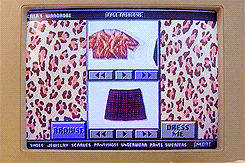
Fashion plays an important role in our lives because it not only makes us more presentable but also a way to express ourselves. Fashion has always been sustainable and clothes are made to be worn as long as possible. However, in recent years, the fashion industry has appeared to be more fast. What does it mean to be fast in this context? Well, fast fashion, is a segment of the fashion industry producing trendy clothes at a low cost in high volumes. This may sound like a positive thing because of the low cost and all but that is not the case. It is causing an environmental impact that may bring harm in the long run. “It dries up water sources and pollutes rivers and streams, while 85% of all textiles go to dumps each year. Even washing clothes releases 500,000 tons of microfibres into the ocean each year, the equivalent of 50 billion plastic bottles.” (Maiti 2024)

The main purpose of this blog post is to encourage slow fashion to achieve a more sustainable fashion industry and to do our part in being more environmentally friendly. So, what is slow fashion? Slow fashion is the exact opposite of fast fashion. According to Hill (2023), slow fashion involves an understanding of and attitude towards fashion that gives considerable thought to the methods and materials needed to produce clothes. It promotes the purchase of longer-lasting, higher-quality clothing and maintains the principle of treating people, animals, and the environment fairly at every turn.
There are plenty of advantages in slow fashion but the biggest factor is to save and improve the environment before it’s too late. The impact of fast fashion may not seem huge at the moment, but it surely is slowly contributing to global warming. Slow fashion should be encouraged because it is beneficial in the long run. Slow fashion clothings are produced at a higher quality which is made to be more durable. When our clothes have better durability, naturally we purchase fewer clothes and help reduce consumption. (Kulczycki 2021)
Shopping and purchasing from sustainable brands are way more ideal. One recommended brand would be Nudie Jeans. Nude Jeans’ denim is 100% organic and crafted by one of the finest denim mills in the world, which has produced high-quality fabrics for over 70 years.

In summary, the fashion business has significance to our lives since it serves as a means of self-expression and presentability This blog post promotes slow fashion as a more environmentally friendly option. We can lessen the negative effects of fast fashion, contribute less to global warming, and encourage well-made, long-lasting apparel by opting for slow fashion. A useful step towards achieving this aim is to support eco-friendly companies like Nudie Jeans, which is well-known for their premium, organic denim. Ultimately, adopting slow fashion techniques helps the environment and promotes a more environmentally friendly fashion industry.
References
Hill, M 2023, What Is Slow Fashion? - Good On You, Good On You, viewed 17 May 2024, <https://goodonyou.eco/what-is-slow-fashion/>.
Kulczycki, P 2022, 10 Slow Fashion Benefits & Fast Fashion Disadvantages | Infographic, SANVT, viewed 18 May 2024, <https://sanvt.com/blogs/journal/advantages-of-slow-fashion?country=MY>.
Maiti, R 2024, Fast Fashion: Its Detrimental Effect on the Environment, Earth.Org, viewed 17 May 2024, <https://earth.org/fast-fashions-detrimental-effect-on-the-environment/#:~:text=It%20dries%20up%20water%20sources,of%2050%20billion%20plastic%20bottles>.
0 notes
Text
Week 6. Slow Fashion
"What you wear says something about you, right? Yeah, you wear that shirt it says you like that band. You wear those combat boots, it says you're edgy.
Fashion is a huge part of our culture. "
1. Setting the scene: The Glamour Facade
Fast fashion, like a fast-food version of high fashion, characterized by its cheap prices and rapid turnover of trendy clothing, has become a dominant force in the apparel industry (Nguyen 2023). However, the allure of fast fashion hides a darker reality of environmental harm, exploitation, and unsustainability.
One defining aspect of fast fashion is its affordability. Brands like Zara and H&M achieve this by mimicking designer styles at a fraction of the cost, making fashion trends accessible to the masses (Nguyen 2023).
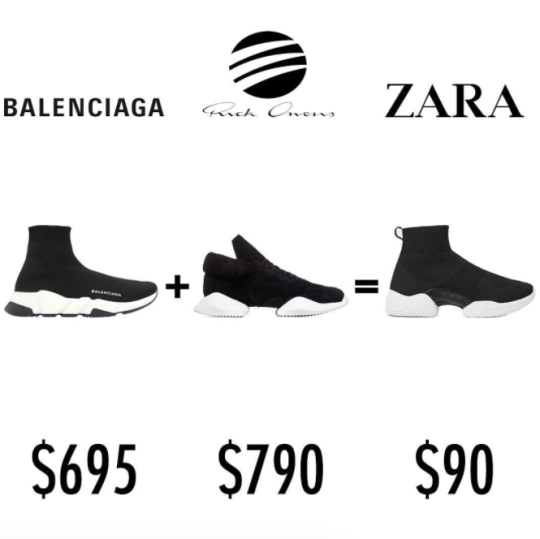
While this democratization of fashion may seem positive, it comes at the expense of quality. Fast fashion garments are often made from low-quality fabrics that are difficult to recycle and end up in landfills or polluting waterways (Hanson 2019). Synthetic materials like polyester contribute significantly to environmental degradation, emitting large amounts of carbon during production and shedding microplastics when washed (Hanson 2019).
Moreover, the production processes involved in fast fashion are environmentally damaging. From the extraction of raw materials to textile dyeing, toxic chemicals are used and often disposed of improperly, polluting water sources (Drew & Yehounme 2017). Additionally, fast fashion relies on cheap labor, often in developing countries, where workers are subjected to poor working conditions and low wages (ABC News (Australia) 2023).


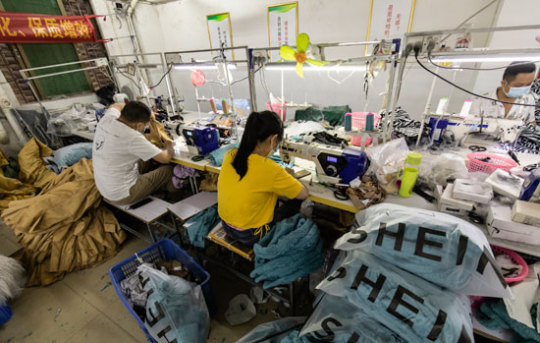
Economically, the fast fashion industry is booming, with the global apparel market valued at over 1.53 trillion U.S. dollars and predicted to reach nearly 2 trillion U.S. dollars by 2028 (Smith 2023b; Smith 2023a). However, this economic growth comes at a cost. The environmental impacts of fast fashion are severe, with the production of synthetic fabrics alone consuming vast amounts of oil and contributing to pollution, as seen in the case of the Citarum River in Indonesia, where factories associated with fast fashion brands have polluted the water, causing health issues such as chemical pollution for local children (Java Discover 2022).

Furthermore, the fast fashion industry's reliance on social media exacerbates its environmental and social impacts. Social media often glamorizes a lifestyle where clothes are worn once or twice for the perfect photo (Netflix Is A Joke 2020). This mentality fuels a "disposable wardrobe" attitude, leading to more clothes ending up in landfills. In addition, the constant stream of new trends promoted by influencers pushes people to buy on impulse without considering quality or long-term wear, contributing to the cycle of waste and exploitation (Netflix Is A Joke 2020).
2. The Rise of Slow Fashion
Amidst the challenges posed by fast fashion, the movement towards slow fashion is gaining popularity. Slow fashion emphasizes transparency, sustainability, and ethical practices, offering an alternative to the wasteful and exploitative nature of the fast fashion industry (Domingos, Vale & Faria 2022). The global secondhand clothing market was valued at $177 billion in 2022 and is expected to nearly double by 2027, reaching a staggering $351 billion (Smith 2023c).

As awareness of the environmental and social impacts of fashion grows, consumers are demanding more transparency and accountability from brands (Domingos, Vale & Faria 2022). They are seeking out companies that prioritize sustainability and ethical production methods (Domingos, Vale & Faria 2022). This shift in consumer behavior is prompting businesses to innovate and adopt greener practices to meet the expectations of their customers (Choi & Han 2019).
To qualify as sustainable, fashion labels are adopting four guiding principles:
(1) Child labor-free production
(2) Environmentally friendly materials
(3) Ethical production processes
(4) Long-term relationships across the supply chain
3. First Steps of A Conscious Journey
I'd prefer to call it "slower," knowing that many young people, like myself, occasionally purchase fast fashion items.
a. Evaluate & support slow fashion brands: Look for brands that use environmentally friendly materials and promote fair labor practices throughout their supply chain.
b. Explore thrifting and clothing swaps: Embrace thrifting as a fun and sustainable way to refresh your wardrobe. Visit thrift stores or participate in clothing swaps with friends to give new life to pre-loved garments. Platforms like Big Sister Swap is a prime example. The concept behind Big Sister Swap is simple yet powerful: it's a clothes-swapping platform that is size-inclusive, environmentally conscious, and chic. Users can participate by purchasing a Swap option based on their willingness to donate clothes and their preferences for receiving items in return (Nast 2022).

c. Get creative with DIY: Tap into your creativity by engaging in DIY projects or clothing modifications. Transform old garments into new, trendy pieces through sewing, painting, or embellishing techniques.
d. Utilize social media for inspiration: Social media platforms can serve as valuable resources for sustainable fashion inspiration. Follow influencers like Annika Victoria, an Australian Youtuber who shares insights and tutorials on sustainable fashion practices (YouTube n.d.). Her main claim to fame is her 'make thrift buy' series where she recreates weird internet fashion and does her best to sew it, giving full, in depth tutorials so people can have the mega trendy but done more sustainably and purposefully. (She is retired from YouTube now, but there are plenty of other younger influencers, such as bestdressed or Ally Purugganan. Find the style of thrift you love and let the algorithm shower you with content, hehe.)
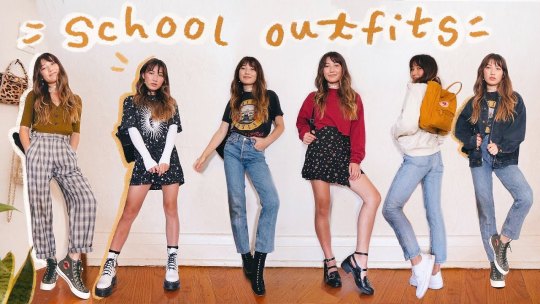

A crucial question remains: How can we support young people in embracing themselves and resisting the harmful influence of consumerism? It's evident they desire many things: they understand the negative effects of fast fashion, yet may not afford slow fashion or may not enjoy thrifting. They seek something that combines the sustainability of slow fashion with the trendiness and convenience of fast fashion.
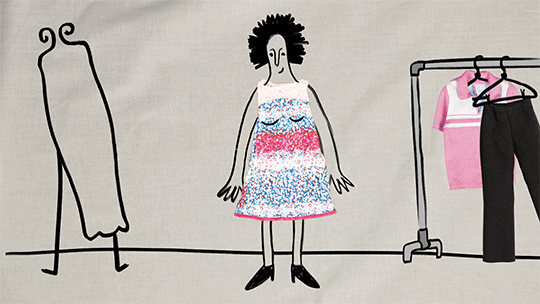
The answer is clear: With every purchase we make a decision that impacts nature and society. If today we prioritize running after toxic trends, tomorrow we will suffer inside and out. Promoting the idea that sustainable consumption leads to a very positive and effective image could be a potential solution for achieving an increase in sustainable fashion (Domingos, Vale & Faria 2022). However, if one cannot fully embrace slow fashion, at least reduce fast fashion consumption and engage in more eco-friendly activities and habits. Fashion is among the most environmentally harmful industries, so every effort counts.
Reference list
ABC News (Australia) 2023, ‘The dark side of Shein’s success | China Tonight | ABC News’, www.youtube.com, viewed <https://www.youtube.com/watch?v=eIuM6lykHxc>.
bestdressed 2020, ‘here are some things i thrifted in nyc :)’, www.youtube.com, viewed <https://www.youtube.com/watch?v=nihjDIczdCA&list=PLTfSzFnwTcWS7PvVG5FM0Uaz5CMLdnVH4>.
Choi, D & Han, T-I 2019, ‘Green Practices among Fashion Manufacturers: Relationship with Cultural Innovativeness and Perceived Benefits’, Social Sciences, vol. 8, no. 5, p. 138, viewed <https://www.mdpi.com/2076-0760/8/5/138>.
Domingos, M, Vale, VT & Faria, S 2022, ‘Slow Fashion Consumer Behavior: a Literature Review’, Sustainability, vol. 14, no. 5, p. 2860.
Drew, D & Yehounme, G 2017, ‘The Apparel Industry’s Environmental Impact in 6 Graphics’, World Resources Institute, World Resources Institute, viewed <https://www.wri.org/insights/apparel-industrys-environmental-impact-6-graphics>.
Hanson, M 2019, ‘Fashion Contributes to 10 Percent of Humanity’s Carbon Emissions’, Big Think, viewed <https://bigthink.com/the-present/is-fashion-bad-for-the-environment/>.
Java Discover 2022, ‘The Fashion Industry’s Dirty Secret: the World’s Most Polluted River in Indonesia | Documentary’, www.youtube.com, viewed <https://www.youtube.com/watch?v=ZHOuJXbZtsk>.
Nast, C 2022, ‘It’s time to get to know Big Sister Swap, AKA the personalised clothes swapping service that everyone is talking about’, Glamour UK, viewed <https://www.glamourmagazine.co.uk/article/big-sister-swap?utm_source=onsite-share&utm_medium=email&utm_campaign=onsite-share&utm_brand=glamour-uk>.
Netflix Is A Joke 2020, ‘The Ugly Truth Of Fast Fashion | Patriot Act with Hasan Minhaj | Netflix’, www.youtube.com, viewed <https://www.youtube.com/watch?v=xGF3ObOBbac&t=1430s>.
Nguyen, HN 2023, Fast Fashion & Greenwashing: the Worst Combination for Sustainability, ResearchGate, pp. 1–7, viewed <https://www.researchgate.net/publication/373632703_Fast_Fashion_Greenwashing_The_Worst_Combination_for_Sustainability>.
Smith, P 2023a, ‘Global Apparel Market - Statistics & Facts’, Statista, viewed <https://www.statista.com/topics/5091/apparel-market-worldwide/#topicOverview>.
Smith, P 2023b, ‘Revenue of the Global Apparel Market 2014-2027’, Statista, viewed <https://www.statista.com/forecasts/821415/value-of-the-global-apparel-market>.
Smith, P 2023c, ‘Secondhand Apparel Market Value Worldwide 2012-2023’, Statista, viewed <https://www.statista.com/statistics/826162/apparel-resale-market-value-worldwide/>.
YouTube n.d., ‘Annika Victoria - YouTube’, www.youtube.com, viewed 27 March 2024, <https://www.youtube.com/@AnnikaVictoria24>.
#swinburne#university#social media#slow fashion#fast fashion#sustainable#fashion influencer#youtube#enviromental#mda20009
0 notes
Text
[Week 6] Slow fashion and Communication Strategy of Fashion Brands on Instagram.
Slow fashion? What is that?
Slow fashion refers to a more eco-conscious strategy within the fashion sector, taking into account environmental and societal consequences, advocating for ethical and transparent manufacturing, and urging consumers to minimize waste while investing in durable, superior-quality products (Minney, 2016).

The Development of Slow Fashion Movement
The slow fashion movement traces its origins back to the slow food movement, which emerged in Italy during the 1980s as a response to the fast-paced, mass-produced food culture. Just as the slow food movement emphasized local sourcing, community connections, and a more mindful approach to eating, slow fashion similarly advocates for local production, transparency, and thoughtful consumption (Fletcher, 2010; Holt, 2009b; Johansson, 2010). This connection underscores the movement's holistic view of fashion, recognizing it as more than just clothing but as a reflection of values and lifestyle choices.
Although the concept of slow fashion has gained traction relatively recently within the textile and apparel industry, scholars have been actively engaged in defining and distinguishing it from related concepts such as sustainability and social responsibility (Clark, 2008; Fletcher, 2010). This ongoing discourse reflects the nuanced nature of slow fashion's principles and objectives, highlighting its multifaceted role in promoting ethical fashion practices.
At its core, slow fashion prioritizes local resources and economies, transparent production systems, and the creation of durable, long-lasting products. By emphasizing quality over quantity, slow fashion seeks to counteract the culture of overconsumption perpetuated by fast fashion (Clark, 2008; Fletcher, 2010; Johansson, 2010). This ethos resonates with a growing consumer awareness regarding the environmental and social impacts of fashion, driving interest and engagement in the slow fashion movement (Fletcher, 2010; Henly, 2010; Siegel et al., 2012).
Fundamentally, slow fashion represents a departure from the growth-driven values of fast fashion. It calls for systemic changes across the fashion industry, advocating for sustainable practices in design, production, distribution, and consumption (Fletcher, 2010). By challenging traditional norms and promoting responsible practices, the slow fashion movement offers a compelling vision for a more ethical and environmentally conscious approach to fashion.

Slow Fashion Brands Collaborate with Influencers on social media as Communication Strategy?

In today's digital landscape, social media influencers are reshaping consumer perceptions and behaviors within the slow fashion movement. These influencers play a crucial role in amplifying the reach and awareness of slow fashion brands, effectively communicating sustainable fashion values to a broader audience (Castillo-Abdul et al. 2021).
However, integrating influencers into marketing strategies raises concerns regarding authenticity and relevance, as issues like a lack of control over messaging and the potential for a "vampire effect" challenge their efficacy (Velasco-Molpeceres et al. 2022).
Moreover, influencers drive a shift in communication strategies, favoring dynamic and engaging content formats on platforms like Instagram and TikTok (Sanz, Perez-Curiel & Velasco, 2020). While this approach captures the audience's attention, slow fashion brands must balance it by emphasizing their values to stand out amidst the content noise.
Despite their potential to promote sustainability, influencers must be more consistent within their business model. While advocating for sustainable practices, they may inadvertently encourage consumption through brand partnerships and product endorsements, undermining the core message of slow fashion. In navigating these challenges, influencers and brands must uphold principles of transparency, authenticity, and environmental responsibility to ensure the continued progress of the slow fashion movement.
References:
Minney, S 2016, “Fashion influencers,” Slow Fashion, Perseus Book LLC (Ingram), United Kingdom.
Castillo-Abdul, B, Romero-Rodríguez, LM & Balseca, J 2021, ‘Hola Followers! Content Analysis of YouTube Channels of Female Fashion Influencers in Spain and Ecuador’, SAGE Open, vol. 11, no. 4, p. 215824402110566.
Fletcher, K 2010, ‘Slow Fashion: an Invitation for Systems Change’, Fashion Practice, vol. 2, no. 2, pp. 259–265, viewed 8 March 2024, <https://www.tandfonline.com/doi/abs/10.2752/175693810X12774625387594>.
Holt, T 2009, Is the time right for Slow Fashion?, Christian Science Monitor.
Johansson, E 2010, ‘Slow fashion - the answer for a sustainable fashion industry?’, Slow Fashion—An Answer for a Sustainable Fashion Industry?
Pookulangara, S & Shephard, A 2013, ‘Slow Fashion Movement: Understanding Consumer Perceptions—An Exploratory Study’, Journal of Retailing and Consumer Services, vol. 20, no. 2, pp. 200–206, viewed 8 March 2024, <https://doi.org/10.1016/j.jretconser.2012.12.002>.
Slow Fashion Award 2010 2010, Cast Your Art, viewed 8 March 2024, <http://www.castyourart.com/en/2010/04/21/slow-fashion-award-2010-wien-aga%20dez/S.>.
Velasco-Molpeceres, A, Zarauza-Castro, J, Pérez-Curiel, C & Mateos-González, S 2022, ‘Slow Fashion as a Communication Strategy of Fashion Brands on Instagram’, Sustainability, vol. 15, no. 1, p. 423.
Wood, Z 2009, Tips for Sustainable Wear, Eartheasy Guides & Articles, viewed 8 March 2024, <https://learn.eartheasy.com/guides/tips-for-sustainable-wear/>. #MDA20009 #SlowFashion #Influencer #SocialMedia
0 notes
Text
Week 6: Digital citizenship case study: Social Media Influencers and the Slow Fashion Movement
Week 6: Digital citizenship case study: Social Media Influencers and the Slow Fashion Movement
Definition of slow fashion:
Slow fashion, a term coined by Kate Fletcher, a professor of Sustainable Fashion at the London College of Fashion in 2007, refers to an approach to fashion that prioritizes quality over quantity. It encompasses traditional craft techniques to create durable clothing that lasts longer. In stark contrast to fast fashion, which revolves around rapid trend cycles and focuses on producing inexpensive, disposable garments, slow fashion aspires to produce clothing that is better for the environment and the workers involved in the production process.
The slow fashion movement incorporates various principles, including sustainability, fair trade, local manufacturing, and a strong emphasis on quality craftsmanship. By adhering to these principles, it aims to establish a more ethical and sustainable model for the fashion industry.
In recent years, there has been a notable increase in awareness regarding environmental concerns and the detrimental impact of the fashion industry on the environment. The industry has been criticized for contributing to water pollution and the use of toxic chemicals. However, the rise of the slow fashion movement signifies a shift towards a more sustainable and environmentally friendly approach to fashion.
So how does slow fashion help the environment?
In numerous ways, sustainable fashion brands contribute to a more environmentally friendly industry. These brands prioritize sustainable practices, such as the utilization of organic and natural materials, recycling fabrics, and minimizing water consumption. As a result, they reduce the amount of clothing that ends up in landfills, as well as the release of toxic chemicals into the environment. Sustainable fashion brands also frequently support local craftsmen and artisans, which not only stimulates the economy but also aids in reducing one's carbon footprint. By adopting these practices, sustainable fashion brands strive to create a positive impact on both the planet and society.
Some examples of brand “slow fashion”:
Artknit workshop
A sand-colored organic cotton dress made to order by Artknit Studios.
Organic cotton dress – International shipping from Italy
Artknit Studios creates timeless knitwear with 100% low-impact materials, responsibly produced by Italian manufacturers. The company's partners are committed to anti-waste measures using only certified and locally sourced fibers, true to the brand's "buy less, buy better" motto.
Moon + Sun
Luna + Sun is a wicked Australian fashion line, creating stunningly feminine designs. The company's factory is certified by Ethical Clothing Australia and its products are OEKO-TEX® STANDARD 100 certified.
Little Emperor creates unique, functional and easy-to-wear clothing for children. The company's affordable clothing is made from eco-friendly organic cotton, each product is designed in Sydney, Australia and manufactured in a Sedex approved factory, ensuring a living wage and safe working conditions for workers. From materials and packaging to energy suppliers and banks, Little Emperor does its best for the environment. Named in honor of the adorable emperor penguin, Little Emperor is a member of 1% for the Planet, meaning 1% of sales are donated to environmental nonprofits, helping to protect penguin's house.
Reference list
‘What Is Slow Fashion?’ n.d., State of Matter Apparel, viewed <https://stateofmatterapparel.com/blogs/som-blog/what-is-slow-fashion>.
Wolfe, I 2022, ‘These 15 Slow Fashion Brands Will Help You Ditch Fast Fashion’, Good On You, viewed <https://goodonyou.eco/slow-fashion-brands/>.
0 notes
Text
The Second Annual Abloh Invitational Honors Virgil Abloh’s Dedication to the Global Skate Community

Last December in Miami, Nike and VA Securities honored Virgil Abloh’s enduring creative legacy with a four-day experience during Miami Art Week, rooted in events and exhibitions that manifested Abloh’s Codes, or his methodological design principles that made his work instantly recognizable. Beginning December 9, Virgil Abloh Securities and Architecture c/o Virgil Abloh ™ follow last year’s breakthrough programming with the second annual Abloh Invitational in Miami, which brings together a diverse community of skaters, artists and cultural figures to further Virgil’s mission to support the culture of skate.
Presented in partnership with Nike, the 2023 Abloh Skateboarding Invitational builds upon last year’s event by hosting freeriding sessions, a best trick competition, a free public skate session and more.
“Virgil was dedicated to skate from his youth, immersing himself in skate culture’s magazines, brands, and film parts,” says Shannon Abloh, Virgil Abloh Securities CEO and Managing Director. “Skateboarding shaped his interest in culture, community and creativity, and throughout his life, Virgil brought together athletes from various generations, backgrounds, skate styles, and brand affiliations, using his cultural influence to support them and to continue to build the surrounding community.”
“It’s great to come and celebrate such a special person and get all these people together, and that’s the one thing that Virgil really did – He brings a lot of different people that you didn’t think would necessarily come together,” says Eric Koston, Nike SB Athlete. “Skateboarding is about community and you always want to bring up that next generation and help them out the best you can. Hopefully they take it from there and do what they want with it.”
Community service was integral to Virgil’s creative philosophy. He actively dedicated his time, knowledge and resources to foster the younger generation of creatives around the world. In line with this belief, a full day of the Invitational will be dedicated to community programming. The initiative, titled “FREE GAME,” is based upon Virgil’s open-source principles and is designed to help grant young creatives exclusive access to prominent figures, creators and innovators in skate. The program includes a series of workshops, clinics, tutorials, training sessions and moderated discussions with leaders at the intersection of global design, art and skate.
“Virgil blended the worlds of art, fashion, culture, music and sport in ways that were dynamic and true. At this intersection, he and Nike inspired and invited more audiences to be a part of the conversation, and in turn, fostered a community where participation and partnership went hand in hand,” says Leo Sandino-Taylor, Nike’s VP of Catalyst Brand Management. “The Second Annual Abloh Skate Invitational is a celebration of this community, through skate – the sport Virgil most identified with - and is an invitation for new generations to lift, riff, and carry forth Virgil’s legacy, whether on a deck or in the open canvas of one’s mind.”
The two-day Invitational precedes the launch of two new colorways of the Off-White™ x Nike Terra Forma footwear, alongside a corresponding apparel collection, on December 21. The Terra Forma silhouette, originally launched in December of 2022, was the first original Nike sneaker designed from scratch by Virgil and Nike designers. Follow @arch____itecture for more.





1 note
·
View note
Text
Week 6: Slow Fashion Influencers and Their Impact on Gen Z vs. Millennials
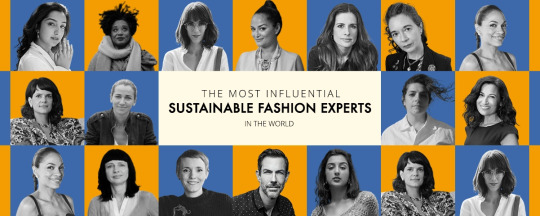
The slow fashion trend is being significantly impacted by social media influencers as sustainability concerns grow. However, the two main consumer groups that are fueling the desire for ethical fashion, Gen Z (born 1997–2012) and Millennials (born 1981–1996), have quite different levels of influence. Despite the fact that both generations consume slow fashion material, there are notable differences in their motivations, consumption habits, and responses to influencers (Domingos et al., 2022).
Gen Z:

Activists with a Digital Background Given their strong ties to social and environmental justice causes, Gen Z is likely to follow influencers who advocate for slow fashion labels and conscientious consumption (Chi et al., 2021). Research shows that Gen Z prefers to follow influencers who provide thorough information about supply chains, ethical sourcing, and brand responsibility because they value authenticity and transparency (Domingos et al., 2022). Their consuming habits are greatly influenced by social media platforms, particularly short video apps like Instagram Reels and TikTok, which prefer brief, aesthetically pleasing information to in-depth explanations (Jung & Jin, 2016).
Millennials: Conscientious, Quality-Driven Shoppers

Millennials are equally interested in sustainability, but quality, longevity, and timeless appeal are more important to them when making purchases (Papadopoulou et al., 2022). Influencers that cater to this group then promote the cost-per-wear philosophy, which favors long-term wardrobe expenditures above fads (Fletcher, 2010). Due to the fact that Millennials are more likely to react favorably to curated, aesthetic content than to short-form, viral videos, Instagram and Pinterest continue to be their preferred sources for slow fashion inspiration (Domingos et al.,2022).
Overcoming the Generation Divide
Both generations, despite their differences, appreciate influencers who promote slow fashion as fashionable and moral. However, Gen Z wants information that is focused on activism, whereas Millennials want content that is practical and applicable to their lifestyle (Chi et al., 2021). Brands that want to connect with both generations must collaborate with influencers that combine inspirational photography with moral storytelling to create visually appealing yet informative content. Influencers remain the bridge connecting eco-friendly firms with consumers as slow fashion gains popularity. Influencers and their followers are responsible for upholding genuine advocacy rather than performative sustainability.
References
Chi, T., Gerard, J., Yu, Y., & Wang, Y. (2021). A study of US consumers’ intention to purchase slow fashion apparel: Understanding the key determinants. International Journal of Fashion Design, Technology and Education, 14(1), 101-112.
Domingos, M., Vale, V. T., & Faria, S. (2022). Slow fashion consumer behavior: A literature review. Sustainability, 14(5), 2860.
Fletcher, K. (2010). Slow fashion: An invitation for systems change. Fashion practice, 2(2), 259-265.
Jung, S., & Jin, B. (2016). Sustainable development of slow fashion businesses: Customer value approach. Sustainability, 8(6), 540.
Papadopoulou, M., Papasolomou, I., & Thrassou, A. (2022). Exploring the level of sustainability awareness among consumers within the fast-fashion clothing industry: a dual business and consumer perspective. Competitiveness Review: An International Business Journal, 32(3), 350-375.
1 note
·
View note
Link
ASW is the only sourcing fair in India that brings together apparel manufacturers from Asia and retailers/brands from around the world on to one comprehensive sourcing platform.
0 notes
Text
The Slow Fashion Movement (Week 6)
The fashion industry is one of the most significant sources of pollution (Domingos, Vale & Faria 2022, 2860-1), from the rapid rate at which clothing is produced to how quickly it is disposed of. This is emblematic of the broader issue with fast fashion: its prioritisation of consumerism over ethics, which has become increasingly detrimental not only in pollution, but also notably in carbon emission, landfill (cheap synthetic materials) and poor working conditions (sweatshops).
‘The goal of fast fashion companies is to produce the most amount of fashionable and trendy apparel in the shortest amount of time, so consumers can keep up with the fast and ever-changing trend cycles and want to consume more products’ (Mehrjoo & Pasek cited in Chi et al. 2021, p. 101).

To counter this, the slow fashion movement has been gaining traction. Slow fashion refers to the ‘change in core values in the fashion industry’ (Domingos, Vale & Faria 2022, 2860-1) to be more sustainable. This is evident through the idea of Corporate Social Responsibility, in which companies ‘help modify behaviour by raising awareness and generating consumer pressure on other companies to follow the higher ethical standards’ (Brewer 2019, 1902-6). For instance, The Common Good Company has a portion of their website dedicated to sustainability, and backs it up with verifiable evidence.
The discussion surrounding sustainability largely takes place online between digital citizens. This includes Corporate Social Responsibility as well as consumers who tend to emphasise the ‘humanitarian’ (Ladstatter 2019) aspect of slow fashion, as they are aware of the consequences of fast fashion. Special focus is placed on the quality and timelessness of their clothing purchases, in an attempt to ensure that the clothes that these consumers do buy will be sufficiently worn and used. A topical way this is addressed is through the ‘thrifting’ trend in youth culture, as clothes are given another chance to be used instead of ending up in landfills. Furthermore, finding long-lasting, quality ‘vintage’ clothing is heralded, as these pieces are often unique—and thus more valuable (Domingos, Vale & Faria 2022, 2860-9).
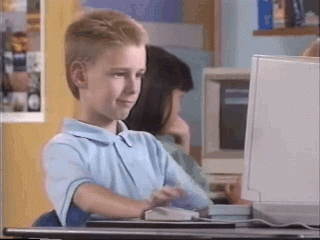
Hopefully, the awareness surrounding fast fashion and the subsequent push for slow fashion will create a higher standard of ethics for clothing production.
>REFERENCES ARE UNDER THE CUT<
Brewer, M.K., 2019, ‘Slow fashion in a fast fashion world: promoting sustainability and responsibility’, Laws, vol. 8, no. 4: 1902.
Chi, T, Gerard, J, Yu, Y & Wang Y, 2021, ‘A study of U.S. consumers’ intention to purchase slow fashion apparel: understanding the key determinants’, International Journal of Fashion Design, Technology and Education, vol. 14, no. 1, pp. 101-112.
Domingos, M, Vale, V.T., & Faria, S, 2022, ‘Slow fashion consumer behavior: a literature review’, Sustainability, vol. 14, no. 5: 2860.
Earth.org 2022, Fast Fashion: The Danger of Sweatshops, Earth.org, viewed 14 April 2023, <https://earth.org/sweatshops/>.
Ladstatter, K, 2019, Thrifting: a growing trend in sustainable fashion. Uloop, Inc.
Sustainable Jungle 2023, Synthetic Fabrics: An Environmental Fashion Faux-Pas?, Sustainable Fabrics, viewed 14 April 2023, <https://www.sustainablejungle.com/sustainable-fashion/synthetic-fabrics/>.
The Common Good Company 2023, Sustainability, The Common Good Company, viewed 14 April 2023, <https://www.thecommongoodco.com/pages/sustainability>.
3 notes
·
View notes
Photo

Major No-Shows at PGA Show
By ED TRAVIS
Planning for the 69th PGA Merchandise Show is well underway, but a list of those renting exhibit space reveals several top companies are missing. The list dated Nov. 18, 2021 does not include the two largest golf equipment companies, Callaway Golf (NYSE: ELY) and Acushnet Holdings Corp. (NYSE: GOLF) nor well-known smaller makers Tour Edge Golf and Wilson Golf.
Missing as well are PXG and TaylorMade Golf though in the case of PXG they have never had a presence at the Show and TaylorMade has not taken booth space for the last three years.
Also on the no-show list are subsidiaries of the big two. Callaway’s Odyssey (putters), Jack Wolfskin (apparel), TopGolf (entertainment), OGIO (bags) and Travis Mathew (apparel) which at past Shows had made the company the largest exhibitor. Acushnet is the maker of Titleist (balls and clubs), FootJoy (shoes and apparel) plus the brands Scotty Cameron (putters) and Vokey Wedges.
When asked for a comment Joe Gomes, Director of Communications for Titleist responded, “Due to the uncertainty of the ongoing pandemic, and with an abundance of caution for the health and safety of our associates, we will not be exhibiting in January of 2022. While we continue to be major supporters of the PGA of America and Reed Exhibitions and are disappointed to not attend this important event on the golf industry calendar, we look forward to returning in 2023.”
The Show is scheduled Jan. 25-28 in Orlando’s Orange County Convention Center after a one-year hiatus when events were held virtually due to the worldwide pandemic. It is the golf industry’s largest annual gathering and serves as a primary source of continuing education for PGA Professionals.
Sponsored by the PGA of America and tagged “The Major of the Golf Business,” in recent years it has occupied 1 million square feet of exhibit and meeting space while drawing 40,000 industry members including PGA Professionals, suppliers, and media. Early estimates for 2022 indicate the numbers attending may be one-third less than in 2020 while the number of exhibitors will be substantially fewer than the 1,000 on the floor for the past several years.
An Oct. 25, 2021, media release from PGA Golf Expositions who run the Show partnering with the PGA of America cited, “A recent survey completed by PGA Professionals and top buyers who frequently attend the PGA Show revealed that 70 percent of PGA Professionals and top buyers currently plan to attend the 2022 PGA Show; 19 percent are undecided with plans to be made within two months prior to the event.”
Concerning the 2022 Show PGA Golf Exhibitions Vice President Marc Simon was quoted, “While we anticipate a temporary contraction in participation this year, we are pleased to share that we are on course to welcome more than 600 golf brands and thousands of industry stakeholders to the 2022 PGA Show.”
Reflecting Simon’s comments there is no doubt people have become more cautious regarding travel and personal interaction, but tradeshow industry experts often point out while online or virtual meetings have their uses businesspeople know personal contact is the best way to build lasting mutually beneficial relationships.
For large companies exhibiting at the PGA Show requires a multimillion-dollar budget and some observers believe justification for this expense may be being reevaluated due to the experience of the 2021 virtual Show. Costs for a floor exhibit include renting space, furnishings and setup plus staff travel and expenses for a week in Orlando not to mention the possibility other projects having to be postponed.
Marketers know current customers may be served via the telephone, email, and evermore effective online software to handle everything from catalog showings to order processing. Face-to-face meetings may then be significantly reduced if not eliminated entirely.
In the past a strong inducement for companies to attend is the Show affords exposure to potential customers, but modern technology can provide a solution to this need also. Using sophisticated algorithms to match computer IP addresses with purchase-intent data lists possible buyers may be identified. Marketing departments can then place customer-specific advertising on viewed websites and initiate email or telephone contact.
On the other hand, some in the industry have repeatedly pointed out no matter the sophistication of virtual meetings or marketing, face-to-face relationship building will never be replaced. It would seem for the golf industry the solution remains to be figured out.
While no one is saying the PGA Merchandise Show is dead organizers will have to find better ways to generate an appropriate return on investment for attendees and companies of all sizes.
10 notes
·
View notes
Text
Nike Takes a Stand for Animal Welfare: Switches to Certified Non-Mulesed Wool

Major Step Towards Animal Welfare
21 June 2023 - In a significant move towards improving animal welfare, global sportswear giant Nike Inc. has announced a major shift in its corporate social responsibility policy. The company has committed to using only certified Responsible Wool Standard (RWS) in its product range, marking a milestone for animal welfare organization FOUR PAWS. For years, FOUR PAWS has been campaigning against the cruel practice of mulesing, and their targeted efforts towards Nike since 2022 have finally paid off. Public Demand and Industry Influence Following in the footsteps of Adidas and Puma, who have already committed to certified wool, Nike's decision comes after over 80,000 sports enthusiasts joined the FOUR PAWS campaign, urging the brand to take action. The campaign, known as #StopCruelWool, continues to call on textile brands to phase out mulesing, a cruel and outdated procedure.
A Shift in Nike's Approach
Nike's public statement declares that the company will exclusively use certified wool sourced with the Responsible Wool Standard (RWS), effectively eliminating the brutal practice of mulesing. Mulesing is primarily practiced in Australia, the largest global supplier of Merino wool. In 2022, FOUR PAWS orchestrated a protest mail that garnered over 80,000 signatures, and athletes participated in marathons in Vienna and Hamburg to raise public awareness about mulesing. As Nike Inc. celebrated its 50th anniversary last year, FOUR PAWS projected their call to end mulesing onto the brand's main European Logistic Campus in Belgium. Commendations and Implications Rebecca Picallo Gil, Head of the wool campaign at FOUR PAWS, commended Nike on this crucial commitment, emphasizing the positive impact it will have on millions of lambs. With the upcoming mulesing season in Australia approaching, this announcement comes at a critical time and sends a strong message to wool producers. As an influential brand with the potential to inspire the entire apparel market, Nike's decision marks a significant win for animal welfare in the sports apparel industry.
Collaboration for Change
To further efforts in ending mulesing in Australia, FOUR PAWS, Humane Society International Australia, and RSPCA Australia have formed a strategic partnership. This partnership prioritizes regular engagement with major international brands like Nike, as well as numerous wool growers across Australia, in response to the growing demand for non-mulesed wool. The three organizations encourage the wool industry to accelerate the transition away from mulesing by adopting better genetics for producing non-mulesed wool, aligning with global brand expectations and satisfying consumer demands.
Background: The Cruelty of Mulesing
Merino wool, known for its breathability and odorless qualities, is extensively used in sports apparel by major global brands, as highlighted in a report by FOUR PAWS. While competitors such as Adidas and Puma had already made public commitments to exclude mulesed wool, Nike, the world's largest sportswear manufacturer at the time, had not responded to public demand until now.
A Call for Change
FOUR PAWS has been campaigning for an end to the cruel practice of mulesing for many years. Mulesing involves cutting off large chunks of skin from lambs, aged between two to ten weeks, without proper pain relief. This procedure causes fear, stress, and intense pain that can last for days. Pain-free alternatives, such as breeding sheep that are naturally flystrike resistant, exist. Additionally, certification systems enable traceability from the shop floor to the farms, ensuring the exclusion of mulesing.
An Industry-Wide Movement
Over 350 brands globally have already published anti-mulesing policies, and more than 70 brands have signed an open letter to the Australian wool industry, demanding an end to the mutilation of lambs. Sources: THX News & Nike Inc. Read the full article
#StopCruelWoolcampaign#AdidasandPumacommitment#Certifiednon-mulesedwool#Cruelty-freewoolbrands#EndingmulesinginAustralia#Merinowoolsportsapparel#MulesinginAustralia#Nikeanimalwelfare#ResponsibleWoolStandard#Woolindustrytransition
0 notes
Text
WEEK 6, SLOW FASHION AND SOCIAL MEDIA THRIFTING
This week's point of discussion was the ‘slow fashion’ movement, explained in the weekly reading as “the need to adopt sustainable performance and a change in core values in the fashion industry” (Domingos, p.1) the term branches out into multiple areas that link with social media.
The slow fashion movement is a direct combatant of fast fashion, which is a business model that seeks to “produce the most amount of fashionable and trendy apparel in the shortest amount of time” (Ting Chi et al, p.101).
The biggest contributors to fast fashion are companies such as Shein and Zara, which have been exposed numerous times to have poor working conditions and wages in order to mass produce clothing that can be sold for cheap.

Where does social media come into slow fashion? TikTok holds a massive number of creators who popularise thrift store ‘hauls’, putting out videos that display items they’ve purchased from thrift stores as a way of promoting slow fashion. On TikTok, #thrifting has over 8.3 billion views

Once again returning to the topic of the influencer, a commonly provided example was Emma Chamberlain, a YouTube and Instagram influencer who found popularity in posting videos about thrift store hauls, this in turn reaches out to her large audience, promoting slow fashion and influencing them to do the same.
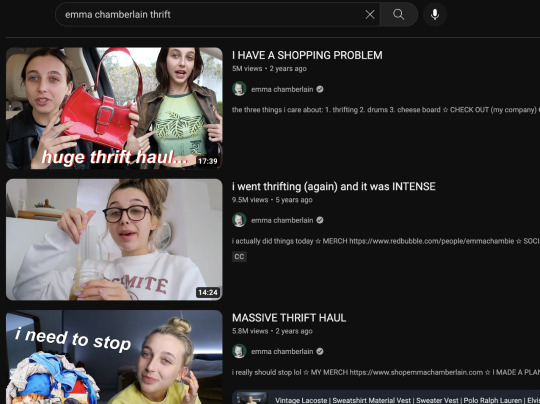
Despite giving thrift stores a type of ‘trendiness’ amongst youth on social media, this also appears to create a form of commercialisation, in where resellers on platforms such as Depop are seen buying up large amounts of thrift store clothes in order to make money reselling, defeating the purpose of the stores as a place where low socioeconomic people can shop for clothing.
Sources
Domingos, M, Vale, VT & Faria, S 2022, ‘Slow Fashion Consumer Behavior: A Literature Review’, Sustainability 14, no. 5: 2860.
Chi, T, Gerard, J, Yu, Y & Wang, Y 2021, ‘A study of U.S. consumers’ intention to purchase slow fashion apparel: understanding the key determinants’, International journal of fashion design, technology and education, 14:1, pp. 101–112.
0 notes